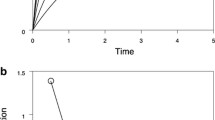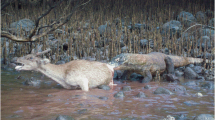Abstract
There is increasing evidence that size variability within a cohort can have important consequences on community ecology and evolution. It is commonly assumed that the threat of predation can influence cohort size variability by homogenizing foraging behavior among members. We combined predictions of growth–defense models with those from models of genesis of size variation to test the non-lethal effects of size-selective newt and gape-unconstrained aeshnid dragonfly larva predators on the size structure of Rhacophorus arboreus tadpoles in a controlled laboratory experiment. We hypothesized that the predators would induce differential growth and behavioral responses in the tadpoles, and would decrease cohort size variation. The tadpoles reduced activity levels in the presence of the predators, but the responses were generally stronger in the presence of dragonfly larvae. Growth costs were commensurate with the levels of behavioral defense investments in the tadpoles. Despite strong reductions in activity levels and growth, cohort size variation increased in the presence of predators, contrasting current models on relationship between foraging rates, growth, and cohort size variation in prey. The underlying mechanisms are unclear, but it is possible that reduced rates of movement limited access to food for some cohort members or that predation risk enhanced the expression of behavioral variation among individuals.


Similar content being viewed by others
References
Bates DM, Maechler M, Bolker B, Walker S (2015) Fitting linear mixed-effects models using lme4. J Stat Softw 67:1–48
Beckerman AP, Rodgers GM, Dennis SR (2010) The reaction norm of size and age at maturity under multiple predator risk. J Anim Ecol 79:1069–1076
Bell AM, Sih A (2007) Exposure to predation generates personality in threespined sticklebacks (Gasterosteus aculeatus). Ecol Lett 10:828–834
Bennett AM, Pereira D, Murray DL (2013) Investment into defensive traits by anuran prey Lithobates pipiens is mediated by the starvation-predation risk trade-off. PLoS ONE 8:e82344
Biro PA, Abrahams MV, Post JR, Parkinson EA (2004) Predators select against high growth rates and risk-taking behaviour in domestic trout populations. Proc R Soc Lond B Biol Sci 271:2233–2237
Bolnick DI, Amarasekare P, Araújo MS, Bürger R, Levine JM, Novak M, Rudolf VH, Schreiber SJ, Urban MC, Vasseur DA (2011) Why intraspecific trait variation matters in community ecology. Trends Ecol Evol 26:183–192
Bourdeau PE, Johansson F (2012) Predator-induced morphological defences as by-products of prey behaviour: a review and prospectus. Oikos 121:1175–1190
Carlson BE, Langkilde T (2017) Body size variation in aquatic consumers causes pervasive community effects, independent of mean body size. Ecol Evol 7:9978–9990
Coleman K, Wilson DS (1998) Shyness and boldness in pumpkinseed sunfish: individual differences are context-specific. Anim Behav 56:927–936
Cote J, Fogarty S, Tymen B, Sih A, Brodin T (2013) Personality-dependent dispersal cancelled under predation risk. Proc R Soc Lond B Biol Sci 280:20132349
De Roos AM, Persson L, McCauley E (2003) The influence of size-dependent life-history traits on the structure and dynamics of populations and communities. Ecol Lett 6:473–487
Fritschie KJ, Olden JD (2016) Disentangling the influences of mean body size and size structure on ecosystem functioning: an example of nutrient recycling by a non-native crayfish. Ecol Evol 6:159–169
Gosner KL (1960) A simplified table for staging anuran embryos and larvae with notes on identification. Herpetologica 16:183–190
Halekoh U, Højsgaard S (2014) A kenward-roger approximation and parametric bootstrap methods for tests in linear mixed models—the R package pbkrtest. J Stat Softw 59:1–30
Hunsinger TW, Lannoo M (2005) Notophthalmus viridescens (Rafinesque, 1820). Eastern Newt. In: Lannoo M (ed) Amphibian declines: the conservation status of United States species. University of California Press, California, pp 889-894
Jolles JW, Manica A, Boogert N (2016) Food intake rates of inactive fish are positively linked to boldness in three-spined sticklebacks Gasterosteus aculeatus. J Fish Biol 88:1661–1668
Kiesecker JM, Blaustein AR, Miller CL (2001) Potential mechanisms underlying the displacement of native red-legged frogs by introduced bullfrogs. Ecology 82:1964–1970
Lenth RV (2016) Least-squares means: The R package lsmeans. J Stat Softw 69:1–33
Lima SL, Dill LM (1990) Behavioral decisions made under the risk of predation: a review and prospectus. Can J Zool 68:619–640
Matsui M, Seki S (2008) Handook of the larvae of frogs, salamanders, and newts in Japan. Bun-ichi Sougo Shuppan, Tokyo (in Japanese)
McNamara JM (1987) Starvation and predation as factors limiting population size. Ecology 68:1515–1519
McPeek MA (2004) The growth/predation risk trade-off: So what is the mechanism? Am Nat 163:E88–E111
Peacor SD, Bence JR, Pfister CA (2007a) The effect of size-dependant growth and environmental factors of animal size variability. Theor Popul Biol 71:80–94
Peacor SD, Schiesari L, Werner EE (2007b) Mechanisms of non-lethal predator effect on cohort size variation: ecological and evolutionary implications. Ecology 88:1536–1547
Peacor SD, Pfister CA (2006) Experimental and model analyses of the effects of competition on individual size variation in wood frog (Rana sylvatica) tadpoles. J Anim Ecol 75:990–999
Pfister CA, Stevens FR (2002) The genesis of size variability in plants and animals. Ecology 83:59–72
Ramamonjisoa N, Rakotonoely H, Natuhara Y (2018a) Differential vulnerability of two sympatric tadpoles to an invasive crayfish predator. Hydrobiologia 818:119–127
Ramamonjisoa N, Rakotonoely H, Yosihiro N (2018b) Defense investments and growth responses under different predation risks and gape-limitation predation threats in a tadpole prey. Behav Ecol Sociobiol 72:144
Riessen HP, Trevett-Smith JB (2009) Turning inducible defenses on and off: adaptive responses of Daphnia to a gape-limited predator. Ecology 90:3455–3469
Roughgarden J, May RM, Levin SA (2014) Perspectives in ecological theory. Princeton University Press, Princeton
Rudolf VH, Rasmussen NL (2013) Population structure determines functional differences among species and ecosystem processes. Nature Communications 4:2318
Steiner UK (2007a) Investment in defense and cost of predator-induced defense along a resource gradient. Oecologia 152:201–210
Steiner UK (2007b) Linking antipredator behaviour, ingestion, gut evacuation and costs of predator-induced responses in tadpoles. Anim Behav 74:1473–1479
Teplitsky C, Laurila A (2007) Flexible defense strategies: competition modifies investment in behavioral vs. morphological defenses. Ecology 88:1641–1646
Thaler JS, McArt SH, Kaplan I (2012) Compensatory mechanisms for ameliorating the fundamental trade-off between predator avoidance and foraging. PNAS 109:12075–12080
Tollrian R, Harvell CD (1999) The ecology and evolution of inducible defenses. Princeton University Press
Uchiyama R, Maeda N, Numata K, Seki S (2002) A photographic guide. Amphibians and Reptiles in Japan, Heibonsha, Tokyo
Urban MC (2007a) The growth-predation risk trade-off under a growing gape-limited predation threat. Ecology 88:2587–2597
Urban MC (2007b) Risky prey behavior evolves in risky habitats. PNAS 104:14377–14382
Urban MC (2008) Salamander evolution across a latitudinal cline in gape-limited predation risk. Oikos 117:1037–1049
Urban MC, Richardson JL (2015) The evolution of foraging rate across local and geographic gradients in predation risk and competition. Am Nat 186:E16–E32
Van Buskirk J (2001) Specific induced responses to different predator species in anuran larvae. J Evol Biol 14:482–489
Woodward G, Ebenman B, Emmerson M, Montoya JM, Olesen JM, Valido A, Warren PH (2005) Body size in ecological networks. Trends Ecol Evol 20:402–440
Acknowledgements
We thank Yoshihiro Natsuhara and the Ecology Group of Nagoya University for hosting the experiment. We thank Harisoa Rakotonoely for the laboratory assistance, Kosuke Nakanishi and Daiki Murakami for their help in collecting the subjects used in the study. We would like to thank the Associate Editor and the two referees for their constructive comments from which our paper has benefited greatly. The work was carried out under current laws and guidelines of Japan and Nagoya University, however no specific permit was required for the conducting the experiment.
Funding
The experiment was partly supported by the Ecological Society of Japan, Chubu division.
Author information
Authors and Affiliations
Corresponding author
Ethics declarations
Conflict of interest
The authors declare that they have no conflict of interest.
Rights and permissions
About this article
Cite this article
Ramamonjisoa, N., Oiire, C., Zheng, X.J. et al. Predation decreases cohort foraging activity and growth, yet increases individual size variation in prey. Evol Ecol 33, 233–242 (2019). https://doi.org/10.1007/s10682-019-09977-0
Received:
Accepted:
Published:
Issue Date:
DOI: https://doi.org/10.1007/s10682-019-09977-0




